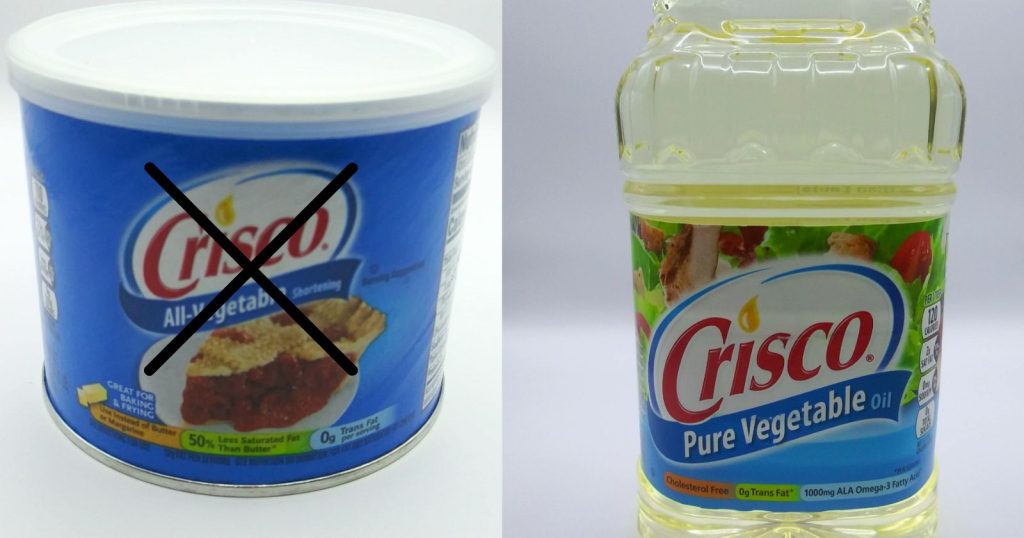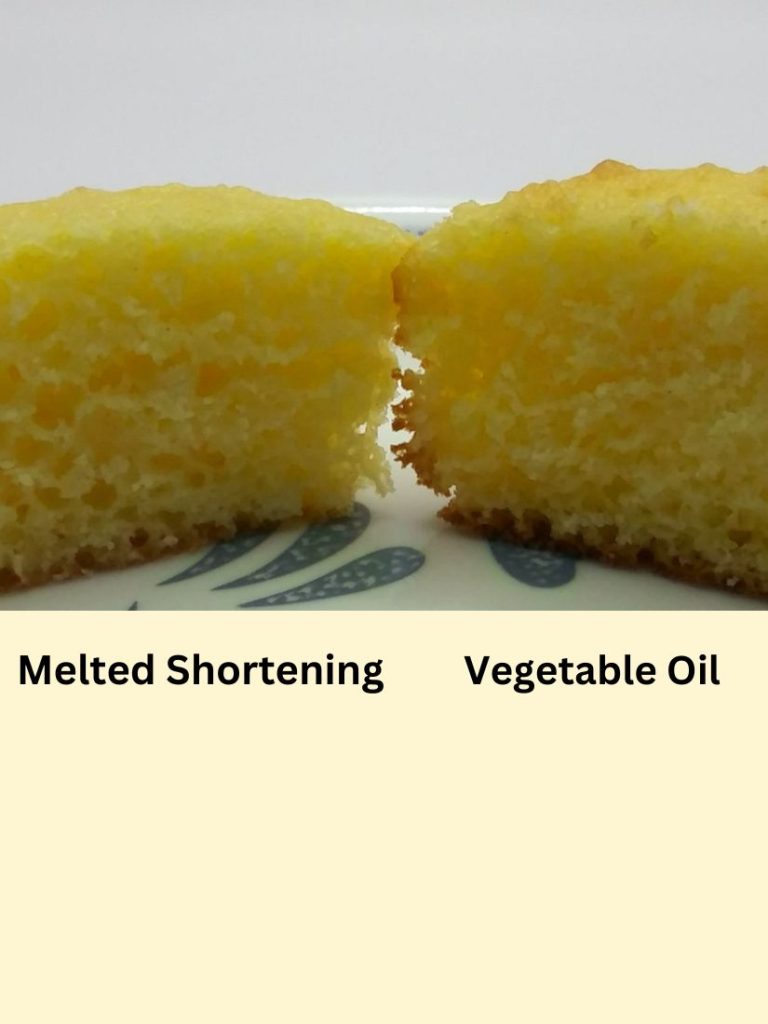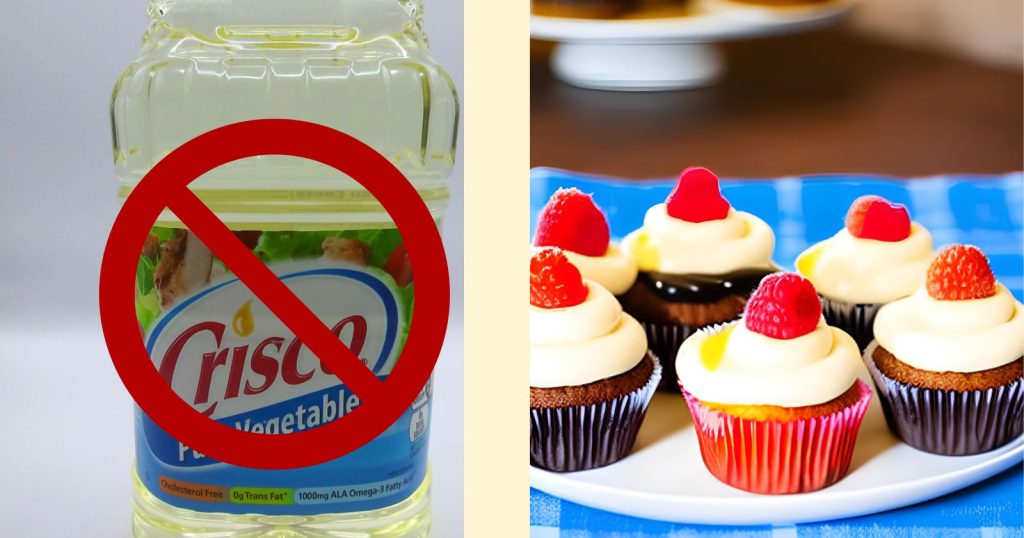Oh, wonderful (sarcasm intended). You’re about to start baking your favorite recipe when you realize you’re out of vegetable oil. Now what? You do have a can of shortening in your pantry. Hmm, Can I use melted shortening for vegetable oil? For most basic baking recipes, you can make this swap in a 1:1 ratio without any major issues. Cookies, cakes, muffins, and quick breads tend to be pretty forgiving. But there are some considerations to think about it. First, we need to know what roles shortening and vegetable oil play in baking.
Shortening VS Vegetable Oil

Shortening and vegetable oil are both fats used in baking, but they have different roles and characteristics that can influence the final texture and flavor of baked goods.
On the surface, it may seem like a no-brainer swap. After all, they’re both flavorless fats made from vegetable oils. But once we dig a little deeper, we uncover a couple of factors that can affect your baked goods.
Shortening is a solid fat made from vegetable oils that have been hydrogenated to solidify them. Its solid nature at room temperature allows it to incorporate more air when whipped, resulting in baked products that are flakier and lighter. Shortening is often used in pie crusts and pastries to give them a tender, flaky texture.
Vegetable oil, on the other hand, is a liquid fat at room temperature. It is generally used in cakes, muffins, and quick bread recipes where a moist and tender crumb is desired. Since it does not solidify at room temperature, vegetable oil does not trap air the way shortening does, and thus it imparts a denser, more moist texture to the finished product. In some recipes, vegetable oil can be substituted for shortening, but it may change the texture of the baked good, making it less flaky and more moist.
One difference is the ratio of saturated to unsaturated fats. Vegetable oil is fully unsaturated, while shortening contains some saturated fat. This means shortening is more solid at room temperature. What does this mean for your baking?
Well, introducing some solid fat into your recipe instead of purely liquid oil can potentially affect the texture. Cakes, cookies, and quick breads may turn out a bit more dense. Pie crusts may end up a little more flaky. Is this a good or bad thing? Well, it depends on the recipe and your preferences!
If keeping the exact same texture is super important to you, I’d advise sticking with vegetable oil when that’s called for. But if you’re open to a slight change in mouthfeel, go ahead and melt that shortening!
Should I Just Avoid This Substitution Altogether?

At this point, you may be feeling unsure about whether to sub in melted shortening after all. Let me offer a bit of encouragement—don’t overthink it!
For most basic baking recipes, you can make this swap in a 1:1 ratio without any major issues. Cookies, cakes, muffins, and quick breads tend to be pretty forgiving. Just use common sense based on the recipe.
If it seems like texture and moisture content will be really important, like for a delicate cake, you might want to stick with vegetable oil or do a test run first. For things like brownies and banana bread, the shortening will likely go undetected.
Some baked goods are more sensitive to this change than others due to the difference in fat content and how the fats interact with the other ingredients. Here are a few examples where using melted shortening instead of oil could potentially alter the results undesirably:
- Chiffon and Sponge Cakes: These cakes rely on oil for their moist and tender crumb. Oil is liquid at room temperature, which gives these cakes their soft, delicate texture. Melted shortening will harden as it cools, which could make these cakes denser and less tender.
- Quick Breads and Muffins: Similar to chiffon and sponge cakes, these products also benefit from the moistness that oil provides. Melted shortening may not provide the same moist crumb.
- Certain Cookies: Some cookies, like chocolate chip or oatmeal cookies, can be made with butter, shortening, or oil, and each provides a different texture. Cookies made with oil tend to be softer and chewier, while those made with shortening can be more crumbly. If a cookie recipe specifically calls for oil, it’s likely for the chewy texture that the oil provides.
- Brownies: Brownies made with oil are typically fudgier and more moist than those made with shortening or butter. If you prefer a fudgy brownie, stick with oil.
- Bread: Many bread recipes call for a small amount of oil to tenderize the dough. Using melted shortening instead could potentially result in a heavier, denser loaf.
Want to know more about crumb in baking? Check this out!
Tips for Baking Success With Shortening

Here are a few general tips for successfully using melted shortening in place of vegetable oil:
- Make sure the shortening is fully melted and smooth, with no lumps or chunks. Microwave it for 15-30 seconds if needed.
- Reduce oven temperature by 25°F to prevent any potential burning or over-browning.
- Add a tablespoon or two of water if the batter seems dry and needs a moisture boost.
- Use nonstick pans and spray them well, as shortening can sometimes stick more.
- Check for doneness a few minutes earlier than the recipe states, as shortening may accelerate baking time.
See, with just a little care and tweaking, you can totally use melted shortening when you run out of regular oil! I’d say it’s absolutely worth trying before you make an emergency grocery store run.
While using melted shortening as a substitute is generally smooth sailing, a few challenges might arise in certain recipes. One common issue is achieving the right texture in cakes. Vegetable oil contributes moisture to the batter, and swapping it with shortening might result in a slightly drier cake. To counter this, think about adding a bit of milk or water to the batter to maintain the desired moisture level.
An Experiment



I made cupcakes from a boxed cake mix. Half of them I made with melted shortening and the other half with vegetable oil. To be accurate, I weighed the cake mix and then divided it by 2. The directions on the back of the box were 1 cup of water, 1/2 cup of oil, and 4 eggs. So for each half, I just divided the ingredients by half. In other words, for each half of the cake mix, I used 1/4 cup melted shortening for one half and 1/4 cup vegetable oil for the other half. Each half also got 1/2 cup water and 2 eggs.
I got 24 cupcakes in total. They both baked for the same amount of time at the same oven temperature. By the images above, the cupcake made with the melted shortening looks just a tad better than the one made with vegetable oil. But when it came to taste, the cupcake made with vegetable oil was just a tad moister. But then I knew which one was made with melted shortening and which one was made with vegetable oil. I asked my husband to taste each one and tell me which one tasted better. He said he couldn’t tell the difference between the two.
No oil? No problem!

No two fats behave exactly the same in baking, so there will always be some difference when substituting. But with a few tweaks, you can totally use melted shortening instead of vegetable oil. Don’t let a lack of vegetable oil stop you from baking something delicious.
Let me know if you give this swap a try in any recipes in the comments below. I’d love to hear how melted shortening compared to the vegetable oil normally called for. Maybe you’ll even find you prefer the slight changes in texture and flavor. At the end of the day, experimenting in the kitchen should be fun and fearless.
So grab that container of shortening from the pantry the next time you run out of vegetable oil. Whip up those cookies, cakes, breads, and more. Your tasty treats will still turn out just fine. Maybe even with some added-on bonuses such as flakiness! Now that’s a baking win in my book.
And As Always
Keep On Baking!
Taianne
Share The Love
FAQs About Using Melted Shortening Instead of Vegetable Oil
With this substitution, you probably have some lingering questions about how melted shortening differs from vegetable oil and how best to use it. Here are answers to some frequently asked questions:
Is melted shortening the same as vegetable oil?
Not exactly. While both are vegetable-based fats, shortening contains some saturated fat, while vegetable oil is fully unsaturated. This means melted shortening will be a bit more solid and have a different moisture content and smoke point, which can slightly alter the texture and flavor of baked goods. The differences are subtle, but vegetable oil and shortening are not quite interchangeable.
Can you melt Crisco for baking?
Yes, you can melt a solid shortening like Crisco to use in place of vegetable oil in most baking recipes. Just make sure it’s fully melted and smooth before adding it to the batter. Microwave it for 15-30 seconds if needed to completely liquefy it. Proceed with a 1:1 substitution and then adjust baking time or temperature if needed based on how the batter looks and behaves with the melted shortening.
Can you use shortening in a cake mix?
Absolutely! Shortening is commonly used in cake mixes and frostings. Since cakes can be sensitive, it’s best to use the melted shortening in a 1:1 ratio without adjusting the amount. You may want to reduce the oven temperature slightly to prevent overbrowning. Also, watch carefully for doneness, as the shortening may accelerate baking time. With just these tweaks, using melted shortening in boxed cake mixes should turn out great.

I’m Taianne, the owner and operator behind We Are Baking. Baking my first cake at age 11 hooked me on creating sweet treats. Though my interest faded during childhood, it was rekindled when I married my apple pie-loving husband. I love trying new recipes, tweaking classics, and helping others learn the science and art of baking. I started We Are Baking to share tips, tricks, and favorite recipes I’ve discovered over the years. When not in the kitchen, I enjoy spending time with family and friends. My goal is to inspire others to embrace their creativity through baking. Feel free to contact me with any questions!
Taianne@wearebaking.com

